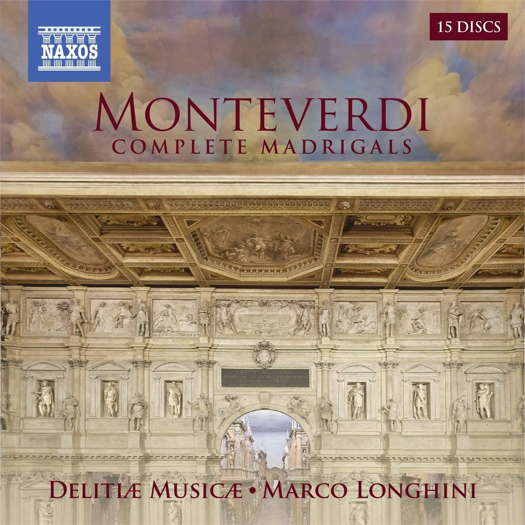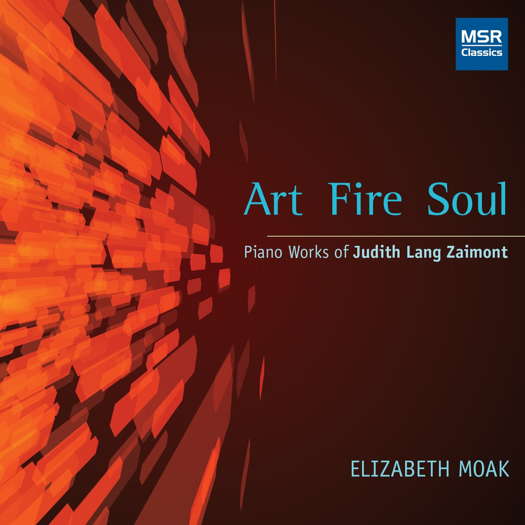 SPONSORED: Think of Something Beautiful - Malcolm Miller pays tribute to contralto Sybil Michelow (1925-2013).
SPONSORED: Think of Something Beautiful - Malcolm Miller pays tribute to contralto Sybil Michelow (1925-2013).
All sponsored features >>

A Philological Discovery
GIUSEPPE PENNISI listens to a Naxos boxed set of Monteverdi madrigals
'I think it was successful and is worth listening to by those accustomed to different ways of performing Monteverdi.'
On the shelves where I collect my records, vinyl and CD, I have several versions of Monteverdi's madrigals. There are those issued some fifty years ago by the low cost publishing house Nonesuch and entrusted to the vocal and instrumental soloists of the Società Cameristica of Lugano conducted by Edwin Loherer. In addition, there are those conducted by Raymond Leppard (who took Monteverdi to the Glyndebourne Festival) with various ensembles as well as those by Michel Corboz with the Lausanne Vocal and Instrumental Ensembles performing with ancient instruments. Finally, the more recent rendering by Roberto Gini with several Cremona vocal and instrumental ensembles and those conducted by Nikolaus Harnoncourt.
For several years, Harnoncourt's have been considered 'the reference recording', also because of the fortunate success of his Zurich Opernhaus hit of the three Monteverdi operas and the related videotapes, initially, and later DVDs, often cast on TV.
As good as they are, these renderings do not have the right touch in looking at Monteverdi as a composer crossing between two ages: Renaissance and Baroque. Most of them are a real pleasure for the ears but either tilt Monteverdi towards the Baroque style (Harnoncourt) or adapt Monteverdi to a modern audience's taste (Leppard).
This impressive set issued by Naxos - fifteen CDs and nine booklets - is the result of a long and steadfast work to play Monteverdi as similarly as possible to how it was played in his own times. He lived from 1567 until 1643, a long period with major changes in the towns where he mostly operated - Cremona, Mantua and Venice. The changes involved politics and culture. In the field of music, they entailed transition from Renaissance to Baroque. The set is the outcome of research by Marco Longhini (the conductor) and his ensemble (Delitiae Musicae) to find the proper touch in rendering Monteverdi's work. In fact, the set includes not only the nine books of madrigals in the strict sense, but all Monteverdi's compositions (including ballet music), with the exception of his three operas. It is a true philological discovery that enables the listener to follow Monteverdi gradually from his initial Renaissance style to his later Baroque.
Longhini and Delitiae Musicae had to make several performance and interpretation decisions, carefully detailed and explained mainly in the first of the nine booklets. The most important decision is the use only of male singers as was customary in churches (but not in courts) at the time. The combination of countertenors, tenors, baritones and basses provides a fascinating mix of timbres, never heard on previous recordings. Other innovations are more technical: changes in the final cadence chord from minor to major, the use of 'small clefs', the specifications of basso continuo and the like. In summary, the effort was to render Monteverdi as it was played and listened to in his times. I think it was successful and is worth listening to by those accustomed to different ways of performing Monteverdi.
This review is necessarily less detailed than those normally published in this magazine because a thorough analysis of the fifteen CDs would require an essay of several pages rather than an article. More importantly, the CDs and their associated booklets have an integrity that can be grasped best by listening, and reading, all of them in a sequence – some twenty hours of listening. They follow Monteverdi's path from Renaissance Court music to Baroque Church, concert and even theatre music.
This integrity stems clearly from the first book of madrigals on CD 1. It was published in 1587, the twilight of the Renaissance. It was written before the introduction of basso continuo as accompaniment. Most likely, in actual performances there was instrumental music to back up the singing. In the rendering, Marco Longhini and Delitiae Musicae use basso accompagnato. This gives an archaic flavour as on CD 1 tracks 19, 20 and 21.
Listen — Monteverdi: Arsi Ed Alsi A Mia Voglia, Contra Risposta (Madrigals, Book I)
(CD1 track 21, 0:00-0:29) © 2002-2020 Naxos Rights US Inc :
The second book of madrigals, published in 1590, has some interesting advances toward forms shaped around the lyrics and to sustain them. There is a two part madrigal (CD2 tracks 1 and 2), one of the most famous and most frequently studied pieces of the entire madrigal repertory. Two part pieces – think of da capo arias - would become standard features of Baroque repertoire.
Listen — Monteverdi: Non Si Levav' Ancor L'alba Novella (Madrigals, Book II)
(CD2 track 1, 0:02-0:50) © 2002-2020 Naxos Rights US Inc :
The third book of madrigals is the last of what I consider the first of the three phases of Monteverdi's evolution. It was a great success in Monteverdi's time. Initially, it was published in 1592 in Venice and reprinted as many as seven times, the last edition issued in 1621. The cost of publishing was sky rocketing at that time. The reprints indicate a great success not only among the aristocrats but also among the contemporary music lovers at large. The subjects of the lyric change too. Whereas in the first two books the moral aspects prevail, this third book is mainly sensual and deals with love as on CD 3 track 3 and tracks 15 and 16 – a two part madrigal.
The fourth book was published seven times too in Italy and abroad between 1603 and 1644. Most likely, the first printing was delayed by Monteverdi's travel to Hungary, among the retinues of the Duke of Mantua, and also by the publication of Gesualdo's first book of madrigals in 1594. It is dense with innovations. Almost as a seal, Monteverdi opens and closes the book with two almost experimental pieces, CD4 tracks 1 and 20.
Listen — Monteverdi: Ah, Dolente Partita (Madrigals, Book IV)
(CD4 track 1, 0:01-0:57) © 2002-2020 Naxos Rights US Inc :
The fifth book, published in Venice in 1605 takes innovation even further. There is, first of all, a formal change: the traditional five voice madrigal is broken up into duets and trios, inviting more elaborate instrumental writing. It develops into mini-dramas with a strong theatrical sense (CD 5 tracks 4,5,6 and 7).
We feel we are at the very roots of opera: only five years earlier, Euridice by Jacope Peri, on an text by Ottavio Rinuccini, had been performed in Florence by a group of aristocrats who thought they were reviving classical Greek tragedy. The innovation is in the contents too, with stronger emphasis on expressions.
The sixth book was published in 1614 and is an explorations of the main musical forms of the period with a view of making the most of transition as well as innovation. The central piece is the Lamento d'Arianna (Arianna's complaint); originally it was part of an opera, now lost. In this set, there are both the polyphonic transcription and the solo version of the four part aria (CD6 tracks 1-4 and CD7 tracks 16-20). The polyphonic version has a wealth of sophisticated harmonies and details, whilst the solo version is a highly dramatic theatrical piece which furthermore, in the opera, anticipates a happy ending, as we learn from Ottavio Rinuccini's libretto, a copy of which survived the long road of the centuries. The book includes interesting occasional madrigals commissioned by various authorities. Of these, two arias are especially remarkable (CD7 tracks 14 and 14?), also because they have a very light instrumental accompaniment. In this book, the voices inhabit the vast space of individual expression, taking solo lines sustained not only by vocal harmony but also by one or more instruments.
The seventh book, titled Concerto by Monteverdi himself and published in 1619, takes three CDs in the collection, as it encompasses thirty-two compositions. The central innovation is that there are no traditional five voice madrigals but pieces from one to four voices. In some, the violins join the basso continuo to support the voices. In short, it is an experimental collection that for its innovation attracted musicologists of the rank of Malipiero. It is a rather eclectic collection, From seduction madrigals (eg CD 8 track 5) and sensual madrigals (such as CD 9 track 2) to mythological ballet madrigals (CD 10 tracks 13-19).
The eighth book (CD 11, 12, 13 and 14) was published in 1638 and contains works of Monteverdi's maturity when the transition from Renaissance to Baroque had been made. These are some of the madrigals most performed today either in concert or even in scenic-theatrical form. The vocal ensemble is enlarged to more than five performers. The basso continuo is complemented with a baroque string ensemble and four bass viols. The book includes the Combattimento di Tancredi e Clorinda, a sixteen number dramatic action which is frequently staged; this is a short opera with an impressive start (CD 12 track 1) and a sad ending (CD 12 track 16).
Equally important are the Madrigali Guerrieri or war madrigals in CD 11 to juxtapose with the Madrigali Amorosi or love madrigals on CD 12. The start of the two cycles is enthralling. (CD 11 track 2 and CD 12 track 25). CD 14 is a philological rendering of the Ballo delle Ingrate, a complete opera ballet first staged in Mantua in 1608 but frequently seen and played (often with modern orchestrations) in opera houses; even a simple listening reveals that the sound is different from that currently heard in opera houses. Now 'high' roles are attributed normally to women (sopranos), but in line with performances in Monteverdi's times, they are entrusted to 'white voices' - children, adolescents and countertenors. There are several female dramatis personae in Ballo delle Ingrate; on CD 14 these roles are performed by countertenors and adolescents' 'white voices'.
In sum, the eighth book is like a Gothic cathedral reaching with its pinnacles to the heaven of music and of musical discovery. The ninth book, published posthumously in 1651, includes what may be called Monteverdi's les pêchés de vieilleuse, as Rossini named his piano works in old age, of an aged composer who had contributed so much to music during his seventy seven years of life. (At that time the average life expectancy was about thirty five.) The book is in CD 15 which includes a number of scherzo musicali. There are two charming pieces on tracks 3 and 19.
This set is a philological discovery to taste slowly and with gusto since it provides twenty hours of excellent music.
Copyright © 4 November 2020
Giuseppe Pennisi,
Rome, Italy

CD INFORMATION: MONTEVERDI COMPLETE MADRIGALS




